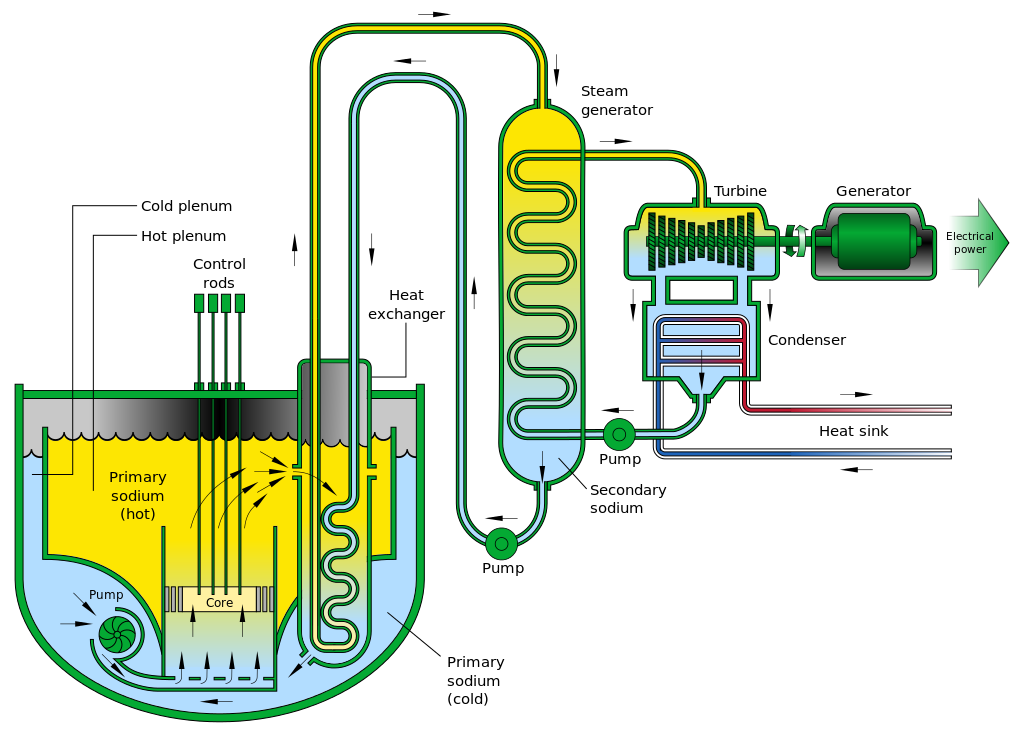Nuclear Reactors 305 - Generation IV Nuclear Reactors - Part 2 of 2 Parts
Part 2 of 2 Parts (Please read Part 1 first)
The second main type of Generation IV reactors is referred to as fast reactors. In a fast reactor, the fast neutrons generated by the fission reaction are directly used without a moderator to slow them down. These reactors can burn or subject to fission all the actinides (which includes uranium, plutonium and fifteen other highly radioactive heavy metals). Since it is the actinides that make nuclear waste so dangerous, burning all the actinides in the fuel can significantly reduce the bulk of nuclear waste and the longevity of its danger. On the other hand, these reactors can be configured to generate more actinides than they burn and thus they can actually “breed” fuel.
The Gas-cooled fast reactor (GFR) is helium cooled and can generate heat at the temperature of eight hundred and fifty degrees Centigrade. It is considered to be an evolution of the VHTR discussed above under thermal reactors. Special fuels are being considered and developed to withstand the high temperatures and to retain the actinides in the original fuel and actinides generated by the fission reaction. Physically, the core configurations will be pin-based, plate-based or prismatic blocks. Construction of a gas-cooled fast reactor will begin in 2018 by the European Sustainable Nuclear Industrial Initiative (ESNII).
The Sodium-cooled fast reactor (SFR) is a sodium molten-salt cooled reactor utilizing fast neutrons. A core with no moderators burns a metallic alloy of uranium and plutonium or any transuranic isotopes. Spent nuclear fuel from LWRs can be used as a fuel. When a SFR overheats, the core expands and the chain reaction slows down so it is what is called “passively safe. One of the main problems with this type of reactor is the fact that the sodium which is cooling the core will react explosively if it comes into contact with water. The liquid metal coolant does allow the reactor to operate at atmospheric pressure which is a plus. India has been researching this type of reactor since the 1980s. They are building a prototype of a commercial reactor and are planning on building six commercial reactors in the near future. The ESNII will make a final decision on the construction of an experimental SFR in 2019. China purchased an SFR from Russia that went operational in 2014.
The Lead-cooled fast reactor (LFR) is a fast neutron reactor cooled by liquid lead or lead/bismuth eutectic in a closed fuel cycle. The fuel is metal or nitride-based composed of fertile uranium and transuranics. Natural convection cools the reactor core and they could be designed to generate heat at a temperature of eight hundred degrees Centigrade for hydrogen production. They can be used in batteries of small reactors or as one large reactor. The ESNII is funding a lead-cooled fast reactor which will be built in Belgium. Russia is building two LFRs, one of which has been redesigned to be proliferation resistant.
The major benefits of the Generation IV reactors are expected to be reduction of the life span and volume of nuclear waste, up to three times more energy from the same amount of fuel, a broader range of possible fuels, the ability to consume spent nuclear fuel from other reactors, and greater safety.
Some of the disadvantages of Generation IV reactors include danger of fire and explosions if sodium coolant contacts water. Lead is not dangerous in contact with water but when compared to sodium, it has higher viscosity, higher density, less heat capacity and more radioactive neutron activation products.
Pool design Sodium-Cooled Fast Reactor:
